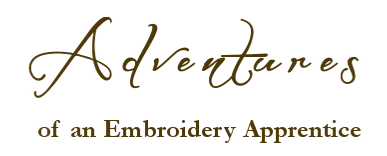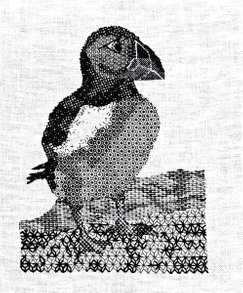Click on the images to enlarge them!
March - June 2021
The Puffin
Teacher Wanted!
When you are exclusively self-taught, you always get to a point where you need some guidance, be it critical or confirming. That was when I began to dream of an apprenticeship at the Royal School of Needlework at Hampton Court, UK. Now it happens that I will probably never have the dough to not only pay for a Day & Evening Class, let alone for a BA (Hons), but also for fare and accommodation in London.
It was on February 15, when it occurred to me that a face-to-face class might not be for me anyway, as I'm not able to embroider 8 hours at a stretch. But maybe there are online courses they offer? Go have a look at their website, I said to myself.
That's when it blew my mind: among other things, they do offer a Blackwork course embroidering a puffin plus a Canvaswork course embroidering a toucan - each of them for a whopping £ 110, which runs up to € 125!!! The Blackwork course contains 12 videos of up to 15 minutes each (with English subtitles, which is essential in my case!) + a kit with all the necessary materials incl. needles and a water soluble pen + access to a closed Facebook group + a stitch review challenge, a gallery and the possibility to leave notes - all that for an entire year with the possibility to prolong the access if you don't manage to finish in time for good reasons.
A self-paced course - what more could I wish for? And yes, even I had € 125 to spare. What came to € 140 in the end, adding the postage for the kit. I didn't have to think long. I went for it.
The only little hitch seemed to be a missing payment option via paypal. Having no credit card, this is usually my only option for transactions with foreign countries. But never fear! A nice guy from David & Charles who run the course proposed to transfer the money to their own paypal account. Everything went smoothly. Got my access to the course immediately.
While waiting for the kit to arrive (9 days, which is quite fast), I went through the videos. It was a very pleasant surprise to see that I had actually done everything right so far. My approach to the technique of embroidery matched mostly to how the pros at the RSN (in this case, Helen McCook, who was involved in the embroidering of Kate Middleton's wedding gown, among other things) are working.
What I most enjoyed learning was that Helen also explained how they approach their projects at the RSN. For me, it has always been a difficult and long-lasting task to set up my own projects. Now I only heard it once, and promptly everything seemed so easy that I asked myself why I had always found it so difficult? Just sketch a design, shade it, and then browse your literature for matching stitches. At least in blackwork embroidery this approach works very well.
One Puffin ... Two Puffins ...
February 26 - the kit had arrived! All lovingly packed in a pretty jute bag. Let's get started!
RSN Blackwork Kit - Puffin
As it turned out in discussions in the Facebook group (and as I soon had to notice myself), the machine thread supplied was almost as thick as the stranded cotton, so that the shading between the two was barely recognisable. The machine thread supplied was Mettler 50. The ladies in the group recommended Gütermann or Aurifil, the latter being very hard to get. I ordered a spool of Gütermann 50, but what a disappointment: the Gütermann was even slightly thicker than the Mettler! Maybe it was because it was polyester and not cotton?
The photo below gives proof of this.
A = stranded cotton (single strand); B = Mettler 50; C = Gütermann 50
Whatever the case - after learning from David & Charles that they had always been using Aurifil indeed, but well over a year ago had to switch to Mettler due to supply problems, I embarked on the adventurous search for the Italian wonder thread. In Germany, if at all, only large spools with over 1 km of thread on them were available. And mostly in black.
However, because my first puffin had already progressed so far, I was determined to stitch a second one with coloured accents. For this I also needed red, orange and possibly yellow machine thread. I was searching in Italian shops, even on the manufacturer's website Cucirini Tre Stelle. Sadly, I found no Italian shop delivering to Germany. In the end I bit the bullet and bought four large spools of different colours in Germany.
I didn't regret it. The Aurifil 50 is much finer than the Mettler 50 or the Gütermann 50 (polyester) indeed. So I've been looking forward to my second puffin. But first things first - let's finish the first one. The shading is achieved by using machine weight thread, one and two strands of stranded cotton respectively, and coton à broder for the darkest areas.
Blackwork Puffin #1
The whole puffin took me about one month. I started on March 20 and finished on April 23.
The second puffin went much faster. At least that's how it seemed to me. In reality I was working on it from May 5 to June 19, but in hours it took me 55 for the first and 43 for the second, so the second had stitched faster indeed.
Blackwork Puffin #2
Unfortunately the screen colour problem had struck again. I had ordered what I thought to be red, orange and yellow Aurifil. What I got were two reds and one orange. I think this puffin would look better still with more yellow legs and patch at the beak, don't you think?
But you can definitely see the difference in shading on the belly between the two versions, can't you? That's the difference in thickness between Mettler and Aurifil.
Setting a New Course
I'm absolutely happy to have done this course. My thanks go to all who have been involved in it, most of all to Helen McCook and David & Charles! I have learned so much in the course. I have gained confidence. And ... I have come to a decision.
After exploring a whole couple of embroidery techniques - cross stitch, Assisi work, Colbert embroidery, canvaswork, blackwork, surface embroidery, needlepainting -, I think I have found the techniques that suit me most: blackwork and canvaswork. I love needlepainting, too, the only hitch is that it takes up so much time. If well done, it looks absolutely beautiful, but I'm rather a short-distance runner than a marathoner. I begin to lose it when I'm working on a project for months on end.
Blackwork and canvaswork, on the other hand, are quick and easy to stitch, but for all that open up a tremendous amount of creative possibilities. I find it fascinating to "paint" or "draw" expressive pictures using unusual approaches - as with this puffin.


